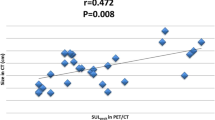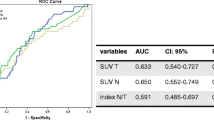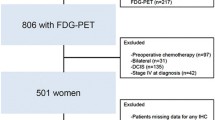Abstract
The aim of this study was to prospectively evaluate the predictive value of 18F-fluorodeoxyglucose–positron emission tomography (FDG–PET) to detect the absence of pathological response to preoperative chemotherapy in patients (pts) with breast cancer. 63 consecutive pts with non-metastatic, non-inflammatory breast cancer, eligible for neoadjuvant chemotherapy (3 FEC 100 followed by 3 Docetaxel) were enrolled. FDG–PET was performed just before the first as well as before the second course. Metabolic activity (tumour FDG uptake) was measured by standardised uptake value (SUVmax). Pts were classified as non-responders (NR) when the decrease of SUVmax in the primary tumour was less than 15% at the time of the second PET (EORTC 1999 criteria). The metabolic response in FDG–PET was correlated with WHO criteria (clinical evaluation and ultrasound and/or mammography) evaluated after three cycles, pathological complete response (pCR) after surgery (according to Sataloff classification) and 4-year relapse-free survival (RFS). The mean SUVmax decrease according to histological response was −52 ± 21% in case of pCR (Sataloff A) and 25 ± 34% in other cases (Sataloff B + C + D). Out of the 16 pts with no PET response (SUV decrease less than 15%), only one had a clinical response after the third cycle, and no pCR was observed. The 4-year RFS rate was significantly longer for metabolic responders than for NR (respectively, 85 vs. 44%; P = 0.01). This prospective study shows that a decrease in the SUV of less than 15% after the first chemotherapy course is a very potent predictor for failure of neoadjuvant chemotherapy, especially of pCR. It is interesting to note that this was shown despite the fact that the chemotherapy regimen was changed after the third course.



Similar content being viewed by others
References
Chollet P, Amat S, Cure H, de Latour M, Le Bouedec G, Mouret-Reynier MA, Ferriere JP, Achard JL, Dauplat J, Penault-Llorca F (2002) Prognostic significance of complete pathological response after induction chemotherapy in operable breast cancer. Br J Cancer 86:1041–1046
Rastogi P, Anderson SJ, Bear HD, Geyer CE, Kahlenberg MS, Robidoux A, Margolese RG, Hoehn JL, Vogel VG, Dakhil SR, Tamkus D, King KM, Pajon ER, Wright MJ, Robert J, Paik S, Mamounas EP, Wolmark N (2008) Preoperative chemotherapy: updates of national surgical adjuvant breast and bowel project protocols B-18 and B-27. J Clin Oncol 26:778–785
Fisher B, Brown A, Mamounas E, Wieand S, Robidoux A, Margolese RG, Cruz AB Jr, Fisher ER, Wickerham DL, Wolmark N, DeCillis A, Hoehn JL, Lees AW, Dimitrov NV (1997) Effect of preoperative chemotherapy on local-regional disease in women with operable breast cancer: findings from national surgical adjuvant breast and bowel project protocols B-18. J Clin Oncol 15:2483–2493
Bear HD, Anderson S, Smith RE, Geyer CE Jr, Mamounas EP, Fisher B, Brown AM, Robidoux A, Margolese R, Kahlenberg MS, Paik S, Soran A, Wickerham DL, Wolmark N (2006) Sequential preoperative or postoperative docetaxel added to preoperative doxorubicin plus cyclophosphamide for operable breast cancer. National surgical adjuvant breast and bowel project protocols B27. J Clin Oncol 24:2019–2027
Heys SD, Hutcheon AW, Sarkar TK, Ogston KN, Miller ID, Payne S, Smith I, Walker LG, Eremin O, Aberdeen Breast Group (2003) Neoadjuvant docetaxel in breast cancer. 3 years survival results from the Aberdeen trial. Clin Breast Cancer 3(Suppl 2):S69–S74
Von Minckwitz G, Raab G, Caputo A, Schütte M, Hilfrich J, Blohmer JU, Gerber B, Costa SD, Merkle E, Eidtmann H, Lampe D, Jackisch C, du Bois A, Kaufmann M (2005) Doxorubicin with cyclophosphamide followed by docetaxel every 21 days compared with doxorubicin and docetaxel every 14 days as preoperative treatment in operable breast cancer: the GEPADUO study of the German Breast Group. J Clin Oncol 23:2676–2685
Dang CT, Hudis C (2010) Preoperative therapy for operable breast cancer. In: Harris JR, Lippman ME, Morrow M, Osborne CK (eds) Diseases of the breast, 4th edn. Lippincott Williams and Wilkins, Philadelphia, pp 715–723
Martoni AA, Zamagni C, Quercia S, Rosati M, Cacciari N, Bernardi A, Musto A, Fanti S, Santini D, Taffurelli M (2010) Early 18F–2-fluoro-2-deoxy-d-glucose positron emission tomography may identify a subset of patients with estrogen receptor-positive breast cancer who will not respond optimally to preoperative chemotherapy. Cancer 2:805–813
Young H, Baum R, Cremerius U, Herholz K, Hoekstra O, Lammertsma AA, Pruim J, Price P (1999) Measurement of clinical and subclinical tumour response using [18F]fluorodeoxyglucose and positron emission tomography: review and 1999 EORTC recommendation. Eur J Cancer 35:1773–1782
Maillez A, Baranzelli MC, Giard S, Ceugnart L, Vanlemmens L, Belkacemi Y, Robin YM, Bonneterre J (2010) Is there a reliable method to assess the complete pathologic response on the tumor after neo-adjuvant chemotherapy in inflammatory breast cancer toward recommendations for the pathologic process? Experience in 56 patients treated in a single institution. Breast J 16:464–471
Elston CW, Ellis IO (1991) Pathological prognostic factors in breast cancer. I. The value of histological grade in breast cancer: experience from a large study with long-term follow-up. Histopathology 19:403–410
Sataloff DM, Mason BA, Prestipino AJ, Seinige UL, Lieber CP, Baloch Z (1995) Pathologic response to induction chemotherapy in locally advanced carcinoma of the breast: a determinant outcome. J Am Coll Surg 180:297–306
Rousseau C, Devillers A, Sagan C, Ferrer L, Bridji B, Campion L, Ricaud M, Bourbouloux E, Doutriaux I, Clouet M, Berton-Rigaud D, Bouriel C, Delecroix V, Garin E, Rouquette S, Resche I, Kerbrat P, Chatal JF, Campone M (2006) Monitoring of early response to neoadjuvant chemotherapy in stage II and III breast cancer by [18F]fluorodeoxyglucose positron emission tomography. J Clin Oncol 24:5366–5372
Schwartz-Dose J, Untch M, Tiling R, Sassen S, Mahner S, Kahlert S, Harbeck N, Lebeau A, Brenner W, Schwaiger M, Jaenicke F, Avril N (2009) Monitoring primary systemic therapy of large and locally advanced breast cancer by using sequential positron emission tomography imaging using [18F]-fluorodeoxyglucose. J Clin Oncol 27:535–541
Smith IC, Welch AE, Hutcheon AW, Miller ID, Payne S, Chilcott F, Waikar S, Whitaker T, Ah-See AK, Eremin O, Heys SD, Gilbert FJ, Sharp PF (2000) Positron emission tomography using [18F]-fluorodeoxy-d-glucose to predict the pathological response of breast cancer to primary chemotherapy. J Clin Oncol 18:1676–1688
Schelling M, Avril N, Nähring J, Kuhn W, Römer W, Sattler D, Werner M, Dose J, Jänicke F, Graeff H, Schwaiger M (2000) Positron emission tomography using [18F]-fluorodeoxy-d-glucose for monitoring primary chemotherapy in breast cancer. J Clin Oncol 18:1689–1695
Berriolo-Riedinger A, Touzery C, Riedinger JM, Toubeau M, Coudert B, Arnould L, Boichot C, Cochet A, Fumoleau P, Brunotte F (2007) 18F]FDG-PET predicts complete pathological response of breast cancer to neoadjuvant chemotherapy. Eur J Nucl Med Mol Imaging 34:1915–1924
Mc Dermott GM, Welch A, Staff RT, Gilbert FJ, Schweiger L, Semple SI, Smith TA, Hutcheon AW, Miller ID, Smith IC, Heys SD (2007) Monitoring primary breast cancer throughout chemotherapy using FDG-PET. Breast Cancer Res Treat 102:75–84
Duch J, Fuster D, Muñoz M, Fernández PL, Paredes P, Fontanillas M, Guzmán F, Rubí S, Lomeña FJ, Pons F (2009) 18F-FDG PET/CT for early prediction of response to neaoadjuvant chemotherapy in breast cancer. Eur J Nucl Med Mol Imaging 36:1551–1557
Kumar A, Kumar R, Seenu V, Gupta SD, Chawla M, Malhotra A, Mehta SN (2009) The role of 18F-FDG PET/CT in evaluation of early response to neoadjuvant chemotherapy in patients with locally advanced breast cancer. Eur Radiol 19:1347–1357
Schneider-Kolsky ME, Hart S, Fox J, Midolo P, Stuckey J, Hofman M, Ganju V (2010) The role of chemotherapeutic drugs in the evaluation of breast tumour response to chemotherapy using serial FDG-PET. Breast Cancer Res 12:R37
Oshida M, Uno K, Suzuki M, Nagashima T, Nagashima T, Hashimoto H, Yagata H, Shishikura T, Imazeki K, Nakajima N (1998) Predicting the prognoses of breast carcinoma patients with positron emission tomography using 2-deoxy-2-fluoro[18F]-d-glucose. Cancer 82:2227–2234
Kim SJ, Kim SK, Lee ES, Ro J, Kang S (2004) Predictive value of [18F]FDG PET for pathological response of breast cancer to neoadjuvant chemotherapy. Ann Oncol 15:1352–1357
Acknowledgments
The authors are grateful to Samia Habbas and Yvette Vendel (Clinical research department of the Oscar Lambret Center) for their helpful contributions. They would also like to thank Dr. Elisabeth Baumelou-Torck-Bonnet for her useful advice. This study was conducted by the sponsor, the Oscar Lambret Center, and supported by a governmental grant (PHRC 2004).
Conflict of interest
None.
Author information
Authors and Affiliations
Corresponding author
Rights and permissions
About this article
Cite this article
Kolesnikov-Gauthier, H., Vanlemmens, L., Baranzelli, MC. et al. Predictive value of neoadjuvant chemotherapy failure in breast cancer using FDG–PET after the first course. Breast Cancer Res Treat 131, 517–525 (2012). https://doi.org/10.1007/s10549-011-1832-4
Received:
Accepted:
Published:
Issue Date:
DOI: https://doi.org/10.1007/s10549-011-1832-4




